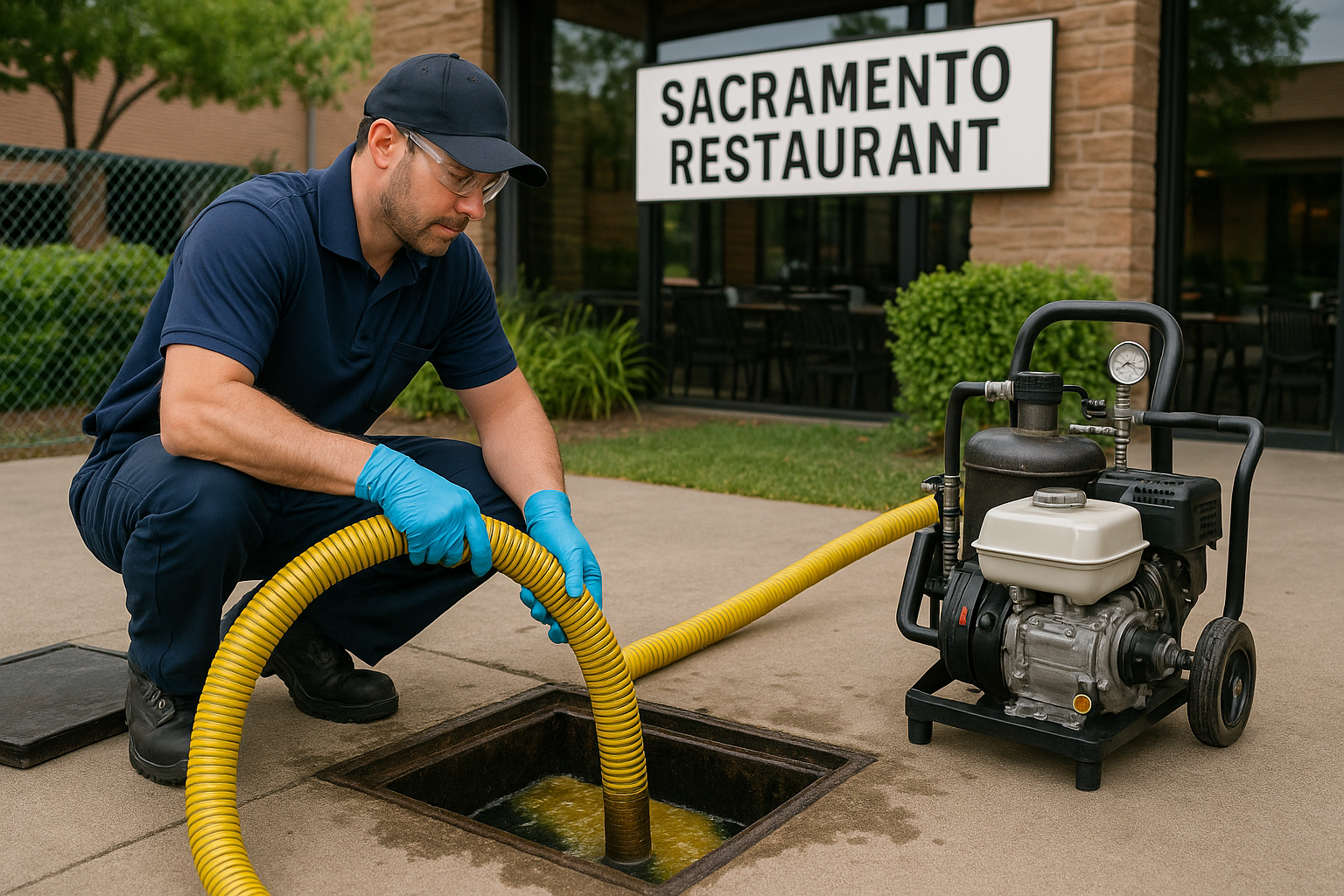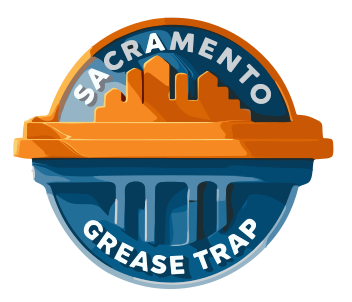What Is a Grease Trap and How Does It Work

Every restaurant, café, and commercial kitchen in Sacramento, CA produces one unavoidable byproduct: grease. From cooking oils and animal fats to butter and sauces, grease is a natural part of food preparation. However, if not properly managed, it can wreak havoc on plumbing systems and damage the environment.
That’s where grease traps come in. These essential plumbing devices prevent fats, oils, and grease (commonly referred to as FOG) from entering the public sewer system, avoiding costly blockages and environmental hazards.
In this guide, you’ll learn what a grease trap is, how it works, and why regular maintenance is crucial for every Sacramento restaurant.
Understanding What a Grease Trap Is and Why It Matters
A grease trap (or grease interceptor) is a plumbing device designed to capture and separate fats, oils, and grease from wastewater before it enters the municipal sewer system.
Installed beneath sinks, dishwashers, or in-ground near drainage lines, the grease trap interceptor prevents greasy buildup that leads to severe clogs, backups, and potential environmental violations.
Essentially, a grease trap acts as a filter. It allows water to flow through while trapping grease, food particles, and solids. The heavier particles settle at the bottom, while lighter oils and fats float to the top. The relatively clean water exits into the sewer system, while the trapped waste remains inside until a scheduled grease trap clean out is performed.
Why Grease Traps Are Important for Sacramento Restaurants
Protecting Plumbing Systems
Without a grease trap, solidified fats and oils can clog drain lines, leading to slow drainage and costly plumbing repairs.
Environmental Protection
When grease enters city sewers, it can cause large congealed blockages known as fatbergs, which damage infrastructure and pollute waterways. Learn more about environmental impacts at EPA.gov.
Legal Compliance
Sacramento and most California municipalities require commercial kitchens to install and maintain restaurant grease traps to comply with local wastewater ordinances.
Operational Efficiency
A properly functioning grease trap prevents kitchen downtime caused by backups and foul odors.
For Sacramento business owners, regular grease trap maintenance is not just a good practice—it’s a legal obligation and a smart investment in long-term plumbing health.
How Does a Grease Trap Work? Step-by-Step Breakdown
Understanding how a grease trap works helps you appreciate its role in maintaining a clean and compliant kitchen. The process relies on density separation: grease and oil are lighter than water, so they naturally rise to the top.
Step 1: Wastewater Enters the Trap
Wastewater from sinks or dishwashers flows into the grease trap inlet. This water contains food solids, oils, and grease.
Step 2: Flow Slows Down
Inside the trap, internal baffles slow the flow of water, allowing time for grease to separate from solids.
Step 3: Separation of Grease and Solids
Fats, oils, and grease (FOG) rise to the surface, while heavier solids sink to the bottom.
Step 4: Clean Water Exits
The cleaner middle layer of water exits through an outlet pipe into the sewer, leaving grease and solids behind.
Step 5: Regular Maintenance and Cleaning
Over time, accumulated grease reduces efficiency. Schedule grease trap cleaning services every 1–3 months to prevent overflow and ensure compliance.
Types of Grease Traps Used in Sacramento
There are two main types of grease traps commonly used in commercial kitchens around Sacramento:
Passive Hydromechanical Grease Traps (Indoor Units)
- Installed under sinks or near dishwashing stations.
- Ideal for smaller establishments or food trucks.
- Require frequent manual grease trap clean outs.
Gravity Grease Interceptors (Outdoor Units)
- Large units installed underground outside the building.
- Suitable for high-volume restaurants.
- Cleaned by professionals using vacuum trucks for grease trap pumping.
Key Components Inside a Grease Trap
- Inlet and Outlet Baffles: Control water flow and retain grease.
- Retention Area: Where grease and solids separate naturally.
- Grease and Sludge Layers: Accumulated waste layers requiring cleaning.
- Access Lid: Allows for inspection and service by technicians.
With proper grease trap maintenance, businesses can avoid thousands in repair costs and maintain compliance with local regulations.
Sacramento Grease Trap Regulations, Maintenance, and Best Practices
Sacramento’s Department of Utilities enforces strict wastewater discharge rules for all commercial kitchens. Every food service establishment must have an approved grease trap or interceptor to prevent grease pollution in the public sewer system.
Local Compliance Requirements
- Installation Standards: Units must meet specific capacity and flow rate standards.
- Maintenance Records: Detailed logs of cleaning and pumping must be maintained.
- Inspection Programs: Regular inspections are performed under the Sacramento County Industrial Waste Program.
- Penalties: Non-compliance may result in fines or even temporary business closures.
For best results, follow FOG Best Practices recommended by Sacramento Grease Trap Cleaning.
Professional Grease Trap Cleaning Services in Sacramento
Partnering with a licensed grease trap cleaning company ensures proper maintenance and compliance.
Professional technicians handle:
- Safe and thorough grease trap pumping and waste disposal.
- Detailed record-keeping for city inspections.
- Odor control and prevention of plumbing issues.
Routine grease trap cleaning near me helps extend the lifespan of your system while maintaining peak kitchen performance.
Signs Your Grease Trap Needs Immediate Service
- Slow or gurgling drains.
- Foul odors near sinks or drains.
- Grease buildup around access lids.
- Overflowing or leaking trap.
Ignoring these warning signs can lead to plumbing failures and potential fines.
Real-World Example: Sacramento Restaurant Success Story
A busy Midtown Sacramento diner serving breakfast daily struggled with frequent clogs and odor issues due to an undersized indoor grease trap.
After upgrading to a larger outdoor grease interceptor and scheduling monthly cleanings with Sacramento Grease Trap Cleaning, their kitchen ran more efficiently, odors disappeared, and city inspections were passed with ease.
This case shows how proper grease trap installation and maintenance can save money and ensure compliance.
Expert Tips for Grease Trap Maintenance and Mistakes to Avoid
Best Practices
- Train staff on proper grease disposal—never pour grease down the drain.
- Pre-scrape dishes to reduce solids entering the system.
- Avoid excessive enzyme treatments that emulsify grease.
- Keep accurate cleaning logs for city inspections.
- Schedule routine professional grease trap clean outs.
Common Mistakes
- Neglecting grease traps until overflow occurs.
- Using hot water or chemicals to “melt” grease—this worsens blockages.
- Installing undersized or non-compliant traps.
- Forgetting to inspect baffles or seals during cleaning.
By following these expert tips, Sacramento kitchens can ensure their restaurant grease traps perform efficiently year-round.
Why Every Sacramento Kitchen Needs Reliable Grease Trap Care
A grease trap might not be the flashiest piece of equipment, but it’s one of the most important for commercial kitchens. It keeps your business running smoothly, your plumbing clear, and Sacramento’s water systems clean.
Routine grease trap pumping and professional care aren’t optional—they’re essential. Partner with Sacramento Grease Trap Cleaning to keep your system efficient, compliant, and odor-free all year long.
Investing in regular maintenance today prevents costly repairs tomorrow and helps protect the Sacramento community’s environment for future generations.
FAQs — Grease Trap Basics
Q1: How often should a grease trap be cleaned?
Most grease traps should be serviced every 1–3 months, following Sacramento’s “25% rule.”
Q2: What happens if I don’t clean my grease trap regularly?
Neglect leads to odors, clogs, sewer backups, and potential fines from local authorities.
Q3: Can I clean my grease trap myself?
Small indoor traps can be cleaned manually, but larger outdoor interceptors require professional grease trap pumping services.
Q4: What size grease trap do I need?
Sizing depends on your kitchen’s volume and water flow. A professional technician can help determine the correct capacity.
Q5: Are grease traps required by law in Sacramento?
Yes. All food service establishments must install and maintain grease traps under local wastewater regulations.

Let Us Simplify Your Grease Trap Maintenance.
Proper grease trap maintenance will reduce costly repairs in the future.
.avif)

